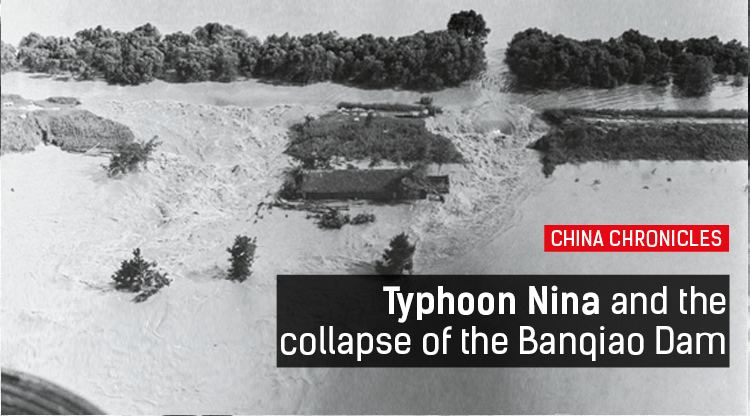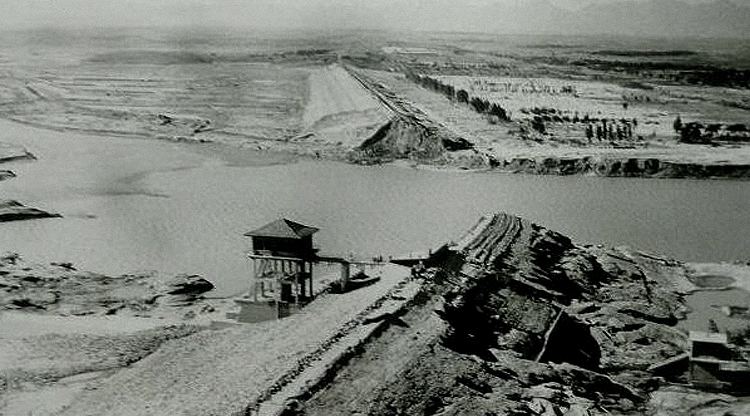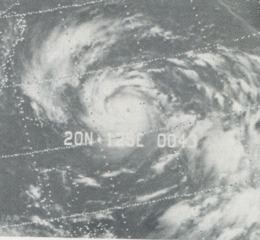Formed July 30, 1975 | Dissipated August 6, 1975 Highest winds 250 km/h | |
 | ||
Lowest pressure 900 hPa (mbar); 26.58 inHg Damage $1.2 billion (1975 USD) Date 30 July 1975 – 6 August 1975 Similar Typhoon Nock‑ten, Tropical Storm Nock‑ten, Typhoon Irma, Typhoon Winnie, Typhoon Rita | ||
Typhoon Nina, known in the Philippines as Typhoon Bebeng. was the fourth-deadliest tropical cyclone on record. Approximately 229,000 people died after the Banqiao Dam collapsed and devastated areas downstream. The collapse of the dam due to heavy floods also caused a string of smaller dams to collapse, adding more damage by the typhoon.
Contents

Meteorological history

A well defined trough line extending southeastward into the Philippine Sea spawned a disturbance on July 29. After initial status as a disturbance, Tropical Depression 04W moved southwestward for 36 hours as the structure of the system began to organize. On July 31, the depression slowed down and began to rapidly intensify to a tropical storm and was named "Nina" then it began to turn to the northwest. A subtropical ridge prevented Nina from turning further north and it began to track west-northwest just before reaching typhoon intensity.

Nina underwent explosive development on the late hours of August 1. Aircraft reconnaissance reported a 65 hPa drop of pressure on the same day as well as August 2 with wind speeds increasing from a mere 65 kn (75 mph, 120 km/h) to 130 kt (150 mph, 240 km/h) during that period and it attained its peak intensity of 135 kn (155 mph, 250 km/h) later that day. The typhoon began to weaken as it approached Taiwan, making landfall near the coastal city of Hualien as a Category 3 storm with 100 kn (115 mph, 185 km/h) winds.
The storm began to weaken as it battered across the island's central mountain range, sparing the most populated areas from the eyewall. It entered the Formosa Straits as a weak typhoon and the storm came ashore near Jinjiang, Fujian, China. After moving toward the northwest and crossing Jiangxi, it turned north on the night of August 5 near Changde, Hunan. A day later, the storm moved over Xinyang, Henan, and later was blocked by a cold front near Zhumadian, Henan for three days. The stationary thunderstorm system brought heavy rainfall, causing the infamous collapse of the Banqiao Dam. The storm moved southwest on August 8, and dissipated soon afterwards.
Taiwan
Upon making landfall in Taiwan, the storm brought winds of 185 km/h (115 mph) to places near the storm's eye. Wind gusts were also measured up to 222 km/h (138 mph). Widespread heavy rainfall, peaking around 700 mm (28 in), from the storm triggered deadly flooding and landslides which killed 29 people and injured 168 others. Reports from the island indicate that 3,000 homes were damaged or destroyed by the typhoon. In the city of Hualien alone, four people were killed, 561 homes were destroyed and 1,831 more were damaged. Across the island, domestic flights, trains, and bus services were all suspended due to the storm; however, Taipei Songshan Airport remained open for international flights.
Mainland China
Due to the interaction with the mountains of Taiwan, Nina weakened to a tropical storm before making landfall in mainland China. The storm crossed the coastline with winds of 110 km/h (70 mph); however, little damage resulted near where the system struck land. Further inland, the remnants of the storm produced widespread torrential rainfall, with more than 400 mm (16 in) falling across an area of 19,410 km2 (7,500 mi2). The heaviest rainfall was recorded along the Banqiao Dam where 1,631 mm (64.2 in) of rain fell, 830 mm (33 in) of which fell in a six-hour span. These rains led to the collapse of the Banqiao Dam, which received 1-in-2000-year flood conditions. In all, 62 dams failed during the disaster, causing large temporary lakes and $1.2 billion (1975 USD) in damage.
